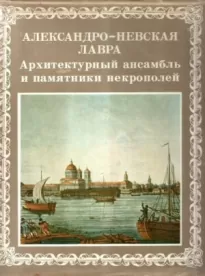Александро-Невская лавра. Архитектурный ансамбль и памятники Некрополей

- Автор: Александр Кудрявцев
- Жанр: Искусство и Дизайн / Путеводители / Неотсортированное
- Дата выхода: 1986
Читать книгу "Александро-Невская лавра. Архитектурный ансамбль и памятники Некрополей"
SUMMARY
The foundation of Alexander Nevsky Lavra (Aleksandro-Nevskaya Lavra) is connected with the important events in the History of Russia.
In 1240 Grand Prince and military commander Alexander Yaroslavich won a major victory in the war with Sweden on the Neva river, for which he was given the title Nevsky and canonized by the Orthodox Church.
In 1702 Russian regiments with Peter the Great as a Commander-in-Chief fought against Sweden for an access to the Baltic Sea. As a result of the Northern War of 1700—1721, when the Russian lands, which had been captured by Sweden in the 17-th century, were at last returned to Russia, the country finally got access to the Baltic Sea by which it could maintain its economic and cultural contacts with Europe. In 1703, Tsar Peter the Great, founded a new capital in the Neva River Delts, and called it St. Peterburg. The Tsar decided to immortalize the name of the great commander of ancient Russia and by his order in 1710 to the south-east of the city center Alexander Nevsky Monastery was founded. The first wooden buildings of the monastery were erected on the left bank of the Chornaya River (now the Monastyrka river) where according to the legend Crusades headed by Byrger were detested.
In 1716 the first architect of Petersburg Domenico Trezzini made a design of a monastery town. In 1917 two-storyed aisles of monastery cells in the easten side were built. Galleries and aisles in the Western, Southern and Northern sides had to be built too. In front of the courtyard a regular park was pesigned. In 1713 a long path was made across an impassable swamp to the center of the city which was to become in 1733 Neva Avenue. In 1724 the first stone church in Lavra, the Annunciation Cathedral (Blagovestchensky Sobor) was built by D. Trezzini in the style of early baroque was concecrated. The remains of Alexander Nevsky encased in a magnificent sarcophagus were brought to the monastery.
The monastery was built during the 18th century. Many outstanding architects, sculptors, builders, decorators and painters tock part in the designing of its churches, towers and aisles. The design of D. Trezzini was taken as a basic one.
Architect Theodore Shwertfeger designed a new cathedral and changed the configuration of the aisles of monastery cells so that the form of „cir-cumferences“ repeated the shape of the river bank. By 1750 the new cathedral was nearly finished but in 1755 it was pulled down because of the technical errors in the desing and a flimsy foundations.
In 1740-1750 architect Pietro Trezzini built South-eastern aisle and the second corner church — Fyodorovskaya.
In 1755 architect M. Rastorguev designed the Western aisle of monastery cells and «Bishop’s House» in baroque style. At the same time the Northern and Southern aisles with open galleries and corner towers were built. The principal church, the Holy Trinity Cathedral (Troitsky Sobor) was built by
Ivan Starov in 1790. The Holy Trinity Cathedral is a brilliant example of the style of Russian Early Classicism and of Russian applied art of the 18th century (the interior). Ivan Starov also worked on the main entrance to the monastery, the stone wall and the adjoining Alexander Nevsky Square which architecturally connected the Monastery with the center of the city. He also united the aisles of monastery cells with the walls of the oldest cemetries of Petersburg.
Peter the Great’s beloved sister Natalia was buried in the monastery in the St. Lazar’s Chapel built in 1717. This started St. Petersburg’s oldest cemetry where courtiers and high dignitaries were enterred. The famous Russian general of Peter’s time B. Sheremetyev, the commander of the cavalry in the Patriotic was of 1812 F. Uvarov were buried there. Among the many outstanding personalities interred in the monastery cemetry were the scientists M. Lomonosov, architects I. Starov, A. Voronikhin, C. Rossi, playwright D. Fonvizin. Many tombstones were designed by talented sculptors and architects such as I. Martos, M. Kozlovsky, A. Voronichin, G. Quarenghim, F. Gordeev and others.
In view of the great cultural and historic importance of the Alexander Nevsky Necropolis it was made a state preserve and a Museum of Urban Sculpture was organized there in 1930.
Tikhvin cemetry was also reorganized then and the remains of main outstanding people were brought there. Among them writers and poets I. Krylov, N. Karamzin, V. Zhukovsky, F. Dostoyevsky; composers M. Glinka, M. Mussorsgsky, A. Borodin, P. Tchaikovsky, A. Dargomyzhsky, main artists, actors and artcritics interred there. The tombstones were designed also by Soviet sculptors M. Manizer, V. Ingal, M. Anikushin and others.
In 1960 — 1970 besides works on restoration the reconstruction of the district near Lavra was carried out. Now the ensemble of Alexander Nevsky Lavra is one of the architectural and historic centres of Leningrad.
АЛЕКСАНДРО-НЕВСКАЯ ЛАВРА. Архитектурный ансамбль и памятники Некрополей
Авторы-составители альбома: Александр Иванович Кудрявцев, Галина Николаевна Шкода
Заведующий редакцией С. Н. Левандовский
Редактор Е. Ф. Петинова
Оформление и макет В. П. Веселкова
Художественно-технический редактор Л. Н. Черножукова
Перевод К. М. Шиловой
Корректор Л. Н. Любимова
ИБ № 722
Сдано в набор 12.10.84. Подписано в печать 10.04.86. М-32058. Формат 60х901/8. Бумага мелованная, 120 г. Печать высокая и глубокая. Гарнитура елизаветинская. Уч.-изд. л. 41,173. Усл.-печ л 38,0 Усл. кр.-отт. 102,75. Тираж 30 000 экз. Изд. № 672179. Заказ 9391. Цена 11 р. 60 к.
Издательство «Художник РСФСР». 195027, Ленинград, Больше-охтинский пр. 6, корпус 2.
Ордена Трудового Красного Знамени Ленинградская типография № 3 имени Ивана Федорова Союзполиграфпрома при Государственном комитете СССР по делам издательств, полиграфии и книжной торговли. 191126, Ленинград, Звенигородская, 11.





